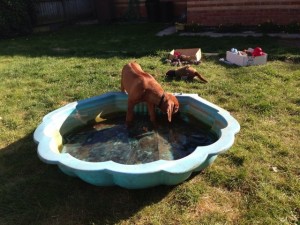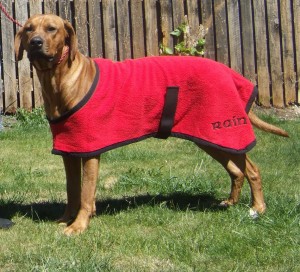Heatstroke Hyperthermic Collapse – Hyper is latin and means high, above or over. It is not to be confused with conditions who’s names start with Hypo (Hypo means exactly the opposite, ie low, below or under)
Today’s tip is about Hyperthermic Collapse (collapse due to the dog having a very high temperature or being subjected atmospherically to high temperatures)
We would expect situations where a dog cannot get out of the heat to cause their body temperatures to rise, for example if they are left in a car in warm weather, even with the window down – or perhaps if you have a “sun-worshiper” who just loves to be out baking his brain in the sunshine all day and doesn’t know when enough sun is enough. However, when dogs are ill, having an epileptic seizure or even being worked very hard, particularly in warmer weather, they run the risk of developing hyperthermic collapse.
.
If you are unsure whether it is too hot to walk your dog, consider how you would feel if you were wearing a fur coat, fur hat and no shoes. Would you still wish to go outside and walk in the searing heat and on the hot road surface? Try placing the back of your hand on the asphalt, tarmac or pavement for 10 seconds and consider how it must feel for a dog to walk his paws directly on such scorching areas. If its too hot for you, then its too hot for them.
.
Please never engage in vigorous exercise in hot weather – even a gentle walk can raise your dog’s temperature dangerously high so restructuring your day to walk your furry friend in the early morning or late evening when things have cooled somewhat is definitely the safest option.Some dogs are in more danger than others and things that can exacerbate the situation include:
.
Infections
Seizures
Poor fitness levels / being over-weight
Normal/high level of exertion or exercise but performed on hot days
Over-excitement
Wearing a muzzle for too long preventing panting
Brachycephalic dogs – (short-faced breeds such as Pugs/Bulldogs) These breeds may have trouble cooling themselves due to their compressed upper respiratory system.
.
Infections
Seizures
Poor fitness levels / being over-weight
Normal/high level of exertion or exercise but performed on hot days
Over-excitement
Wearing a muzzle for too long preventing panting
Brachycephalic dogs – (short-faced breeds such as Pugs/Bulldogs) These breeds may have trouble cooling themselves due to their compressed upper respiratory system.
.
Signs of heat exhaustion include:
- heavy panting
- hyperventilation (deep breathing)
- increased salivation early then dry gums as deterioration progresses
- weakness
- confusion or inattention
- shivering
- vomiting or diarrhoea
- sometimes bleeding
As the condition progresses towards heat stroke there may be:
- obvious paleness or graying to the gums
- sticky or dry gums/tongue rather than the usual wet/slimy texture
- shallowing of the breathing efforts
- slowed or absent breathing efforts
- vomiting and diarrhoea that may be bloody
- seizures or coma
So, what should you do?
Protect from further heat and provide shade
Cool him down immediately with running water or
Provide a paddling pool to stand in, allowing him to drink freely as he stands
.
Cover in a purpose bought cooling coat, towelling robe or towels soaked in cold water.
.
N.B: If you intend to use this technique, remember to keep replenishing the cold water on the towel. If you do not, the water on the inside of the towel will actually heat up and cause what is known as the “sauna effect” and obviously, this is counter-productive to what you are trying to achieve.
.
N.B: If you intend to use this technique, remember to keep replenishing the cold water on the towel. If you do not, the water on the inside of the towel will actually heat up and cause what is known as the “sauna effect” and obviously, this is counter-productive to what you are trying to achieve.
.
.
The feet/face/chest/top of the head/base of the skull are the most effective areas to cool quickly
.
(Following a seizure, back of the neck/top of head/spine are good places to cool)
.
Try wet flannels in the groin/armpit area
.
Offer lots of cool water to rehydrate quickly – if the dog is merely showing signs that he is hot, then frozen Kongs, ice chips or ice cubes in the water will help bring his temperature down. However, if the dog is actually in crisis and you suspect full blown heatstroke, then iced water or ice cubes should be avoided as these can cause a serious reaction in your dog as dangerous or more so than the temperature problem itself.
.
DO NOT plunge your dog into freezing cold water as this could easily send him into shock or even cause a heart attack.
.
DO NOT bring his temperature down too far. Hypothermia is EQUALLY dangerous and once a dog’s temperature falls dangerously low, it will then continue to fall and be very difficult to bring back up.
.
It is vital that you seek emergency veterinary attention should your dog develop heatstroke as this can prove fatal. Ring your vet immediately and have him meet you at the veterinary clinic for urgent rehydration and cooling treatment. Please ALWAYS ring ahead of your arrival to ensure the vet is ready for you so he is able to treat your dog without delay.
.
Average Canine Temp:
The average temperature of a healthy dog is 101 °F (38 °C), however, the normal temperature of a healthy dog may range from around 99 °F to 102.5 °F (37.2 °C–39.2 °C).
.
.


